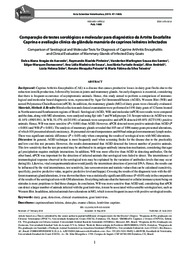Comparação de testes sorológicos e molecular para diagnóstico da Artrite Encefalite Caprina e avaliação clínica da glândula mamária de caprinos leiteiros infectados.
Comparação de testes sorológicos e molecular para diagnóstico da Artrite Encefalite Caprina e avaliação clínica da glândula mamária de caprinos leiteiros infectados.
Autoria: AZEVEDO, D. A. A. de; PINHEIRO, R. R.; SANTOS, V. W. S. dos; DAMASCENO, E. M.; SOUSA, A. L. M. de; ARAÚJO, J. F.; ANDRIOLI, A.; SIDER, L. H.; PEIXOTO, R. M.; TEIXEIRA, M. F. da S.
Resumo: Background: Caprine Arthritis Encephalitis (CAE) is a disease that causes productive losses in dairy goat flocks due to the reduction in milk production, followed by lesions in joints and mammary glands. An early diagnosis is essential, considering that there is frequent occurrence of asymptomatic animals. Hence, this study aimed to perform a comparison of immunological and molecular based diagnostic tests, represented by Agar Gel Immunodiffusion (AGID), Western Blot (WB) and nested Polymerase Chain Reaction (nPCR). In addition, the mammary glands (MG) of dairy goats were clinically evaluated. Materials, Methods & Results: Blood collection and clinical examination were performed in 1191 dairy goats of 12 farms located in Northeastern and Southeastern regions of Brazil. Serological (AGID, WB) and molecular (nPCR) test results were compared and the data, along with MG alterations, were analyzed using Epi-info 7 and WinEpiscope 2.0. Seroprevalence in AGID test was 41.14% (490/1191). In WB, 51.47% (613/1191) of animals were seropositive and nPCR detected 69.44% (827/1191) positive animals. Hence, WB was more sensitive (P < 0.001) than AGID. However, nPCR detected more positive animals than AGID (P < 0.001) and WB (P < 0.001). The analysis of mammary glands revealed that 105 out of 1096 nanny goats presented alterations, of which 101 presented altered consistency, 16 presented elevated temperatures and 60 had enlarged retromammary lymph nodes. There was significant statistic difference (P < 0.05) only when comparing the results of serological tests with MG alterations. Discussion: In general, AGID technique is most frequently used when screening flocks for the disease due to the practicality and low cost this test presents. However, the results demonstrated that AGID detected the lowest number of positive animals. This low sensitivity that the test presented may be attributed to its antigen-antibody interaction mechanism, considering that agar gel precipitation requires multiple interactions. In addition, WB was more effective than AGID in detecting antibodies. On the other hand, nPCR was important for the detection of infected animals that serological tests failed to detect. The intermittence of immunological response observed in the serological tests may be explained by the variation of antibodies levels that may occur during life. Likewise, viral compartmentalization would justify the intermittent detection of proviral DNA. Hence, the results can be influenced by the viral intermittence, test sensitivity, late seroconversion and statistic values that can be calculated (sensitivity, specificity, positive predictive value, negative predictive level and kappa). Crossing the results of the diagnostic tests with the different mammary gland alterations, it was shown that there was a statistically significant difference (P <0.05) only in the comparison of the results of the serological tests with GM alterations. Everything indicates that the humoral or cellular immune system being on stimulus is more propitious to find these changes. In conclusion, WB was more sensitive than AGID and, considering that nPCR can detect a larger number of animals infected with the goat lentivirus, it must be associated with a sensible serological test, such as Western Blot. In addition, infected animals have alterations in MG, which is more frequent in cases with positive serological. [Comparison of serological and molecular tests for diagnosis of caprine arthritis encephalitis and clinical evaluation of mammary glands of infected dairy goats].
Ano de publicação: 2019
Tipo de publicação: Artigo de periódico
Unidade: Embrapa Caprinos e Ovinos
Observações
1 - Por padrão são exibidas publicações dos últimos 20 anos. Para encontrar publicações mais antigas, configure o filtro ano de publicação, colocando o ano a partir do qual você deseja encontrar publicações. O filtro está na coluna da esquerda na busca acima.
2 - Para ler algumas publicações da Embrapa (apenas as que estão em formato ePub), é necessário ter, no celular ou computador, um desses softwares gratuitos. Sistemas Android: Google Play Livros; IOS: iBooks; Windows e Linux: software Calibre.
Acesse outras publicações
Acesse a Base de Dados da Pesquisa Agropecuária (BDPA) para consultar o acervo completo das bibliotecas da Embrapa.

